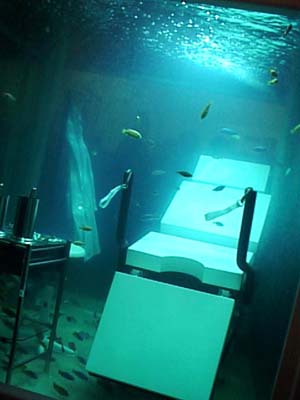
Wrestling with Installation Art
The new exhibit at the Hirschhorn of the 1960s Italian art movement known as Arte Povera has forced me to reconsider my long-standing hostility toward installation art. Years ago when I saw the Damien Hirst show at the Gagosian I found the entire spectacle utterly ridiculous. Put off by the hype and by Hirst's rock-star treatment, I had gone with the intention of rejecting everything, and reject I did. The Arte Povera show, however, did something rather inconvenient. It pleased me. Although most of the installations are impressive only for their one-time originality (in the sense that the entire genre was new), a few are more than merely interesting: they are really charming. I could not help but acknowledge that there is something to this installation art thing after all, a concession that has obliged me to think hard about what I did not like about the stuff in the first place.
My brief against installation art is of two parts. The first has to do with a distinction I draw between installation art and more traditional genres like painting and sculpture. These older forms have a craft element to them. The artist first masters a craft and then deploys his or her mastery to produce a work that achieves an aesthetic ideal. When we take in a sculpture by Michelangelo we are in awe not just of his majestic artistic vision but also of his ability to take hammer and chisel to a chunk of rock and bring that vision to life. In contrast, most installation artists practice no craft more tangible than the exercise of creative thinking. Though many installation artists undeniably possess extraordinary artistic vision, their emphasis on inventiveness rather than mastery of recognized forms lends itself too readily to a situation in which conceptual creativity, which can sometimes be reduced to cleverness, becomes the whole point. My take on Damien Hirst's dead-animal-in-a-tank series, for example, is that we are not supposed to admire his knack for bolting together large aquariums or his taxidermy skills but rather the fact that he has put cadavers in tanks, ostensibly to show us something about bodies, death, and decay, and called it art. Putting aside for a moment the merits of his proposition, I view such craft-less art as intrinsically inferior to craft-based art.
My second complaint against installation art is its emphasis on intellectual abstraction.
Most of the pieces I have seen are trying to make a point and provoke thought.
Often they are intended to challenge our assumptions about art or aesthetics,
to subvert convention, or comment on politics or society - all noble causes,
 but all too often the artists' messages are hopelessly obscure or shallow. Sometimes the point they are making is not worth the work required to 'get it.' Sometimes they seem to be saying nothing more than "hey, look at me, I'm subverting a convention!" Even when installation art has more sophisticated things to say, it speaks to the intellect rather than the heart. It may make me think, but it neither moves nor inspires me.For example, the major pieces at Hirst's Gagosian show consisted of a series of huge glass tanks filled with water, fish, and gynecological examination tables, stirrups and all. I spent a lot of time pondering these aquariums, and the only thing I could derive from them is that Hirst was commenting on the crude association of fish with female genitalia. I found one on-line review that actually confirmed my suspicion. Others indicated that Hirst wanted to comment on things such as corporeality and impermanence. Although I enjoyed looking at Hirst's fish tanks, the point of his work is not about the experience of looking at it but rather about 'getting it,' that is, grasping whatever (pseudo-)philosophical propositions he is trying to make.
but all too often the artists' messages are hopelessly obscure or shallow. Sometimes the point they are making is not worth the work required to 'get it.' Sometimes they seem to be saying nothing more than "hey, look at me, I'm subverting a convention!" Even when installation art has more sophisticated things to say, it speaks to the intellect rather than the heart. It may make me think, but it neither moves nor inspires me.For example, the major pieces at Hirst's Gagosian show consisted of a series of huge glass tanks filled with water, fish, and gynecological examination tables, stirrups and all. I spent a lot of time pondering these aquariums, and the only thing I could derive from them is that Hirst was commenting on the crude association of fish with female genitalia. I found one on-line review that actually confirmed my suspicion. Others indicated that Hirst wanted to comment on things such as corporeality and impermanence. Although I enjoyed looking at Hirst's fish tanks, the point of his work is not about the experience of looking at it but rather about 'getting it,' that is, grasping whatever (pseudo-)philosophical propositions he is trying to make.



film politics music jay's head poetry art josh ring fysche saddies about archive